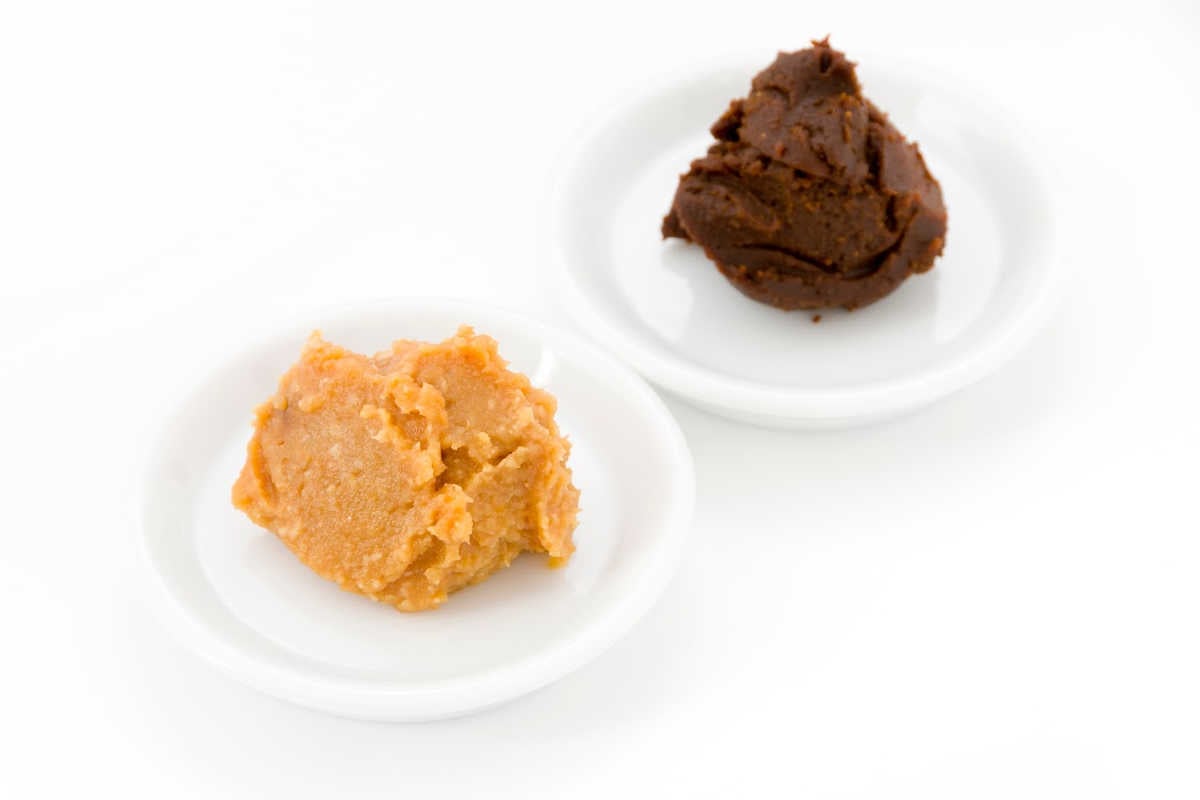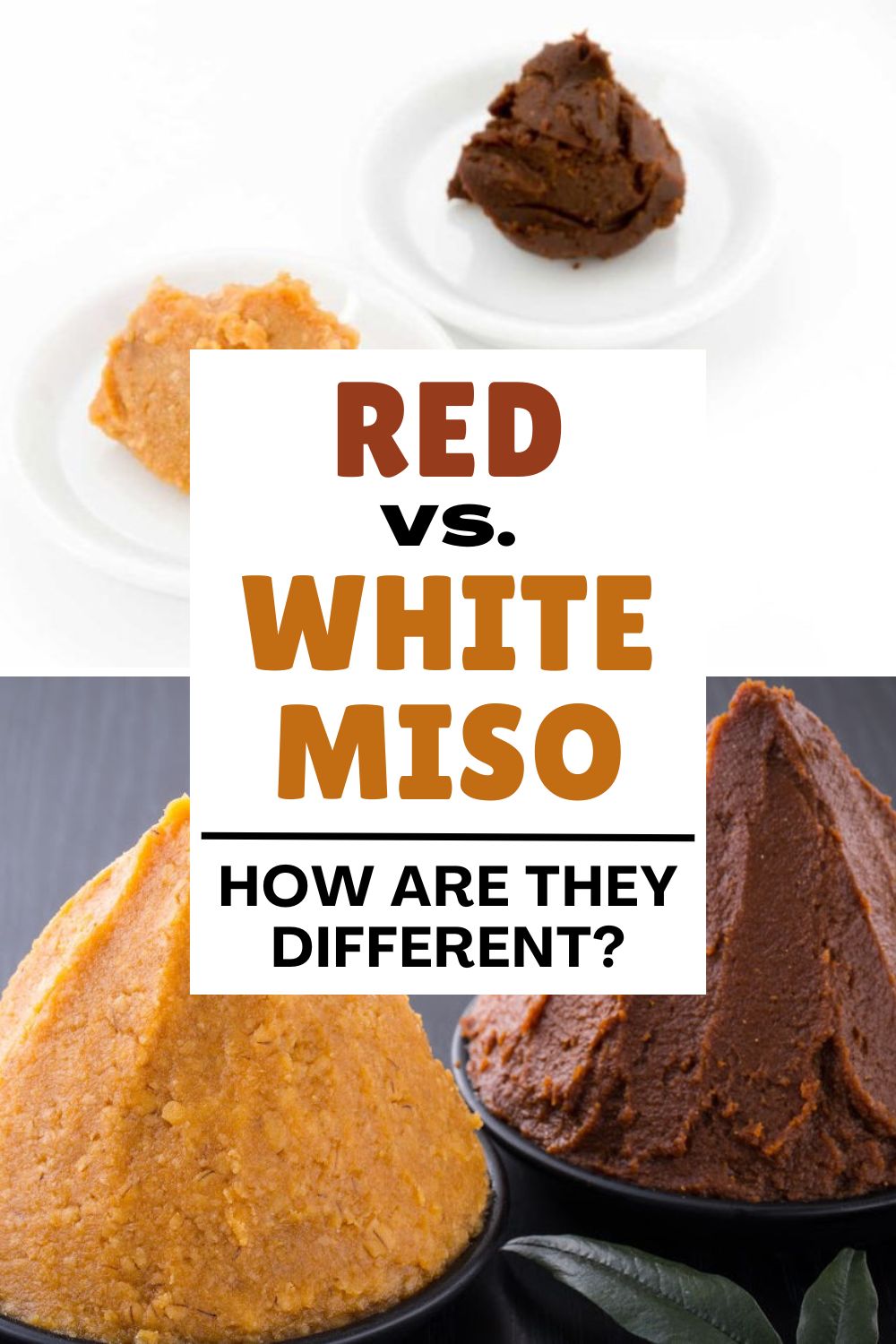Imagine standing in the condiments aisle at the supermarket with a couple of brands of miso paste staring back at you. So you wonder, which type should you buy? If you hate being indecisive, then you’re in luck, we’re hosting the battle of the misos: red vs. white miso.

Did you know that there are over 100 varieties of miso paste? These can be categorized into two main types: red and white miso.
Red Miso Overview
This type is also called Aka Miso, and it’s made by fermenting soybeans and barley for years.
Red miso has a strong umami and salty flavor, making it a perfect addition to many soups and marinades. In a jiffy, we’ll tell you more about red miso.
White Miso Overview
White miso, also known as Shiro Miso, is usually described as mellow and sweet miso.
This variation is made by fermenting rice for some time, resulting in a mild umami and salty flavor. Due to the pale color and gentle taste, white miso is ideal for light sauces and ramen.

Battle of the Misos: Red vs. White Miso
Let’s break down each of the characteristics of red and white miso to describe their difference in detail.
After each round, we’ll choose a winner. Then, we’ll tell you which tub of miso paste wins the overall competition.
Let’s get ready to rumble!
Consistency
Red miso paste is made from crushed soybeans, which are high in fiber. So, the result is a slightly gritty mash, though some manufacturers blend red miso into a smooth paste before fermentation.
Since white miso is made from rice, it has a very smooth consistency that blends well in soups and other smooth foods. Some brands make white miso that’s a little grainy.
Winner
When it comes to consistency, we call a draw between red and white miso. Both kinds can either be smooth or grainy, and this doesn’t affect the final dish in any way.
Appearance
Red miso paste is red to dark brown. The longer the fermentation time, the darker the shade becomes. So, any miso that’s within this range of tints is considered red.
White miso, on the other hand, can be described as white to light beige. Some brands of white miso have a pale yellow hue.
Winner
In this day and age, people might give you funny looks when you side with white, but we’re talking about food here, guys, so kindly take a chill pill.
That being said, white miso beats red miso in this round because it retains the original color of the food you’re making.
Flavor

Red miso tastes umami and salty. It has an intense flavor profile and a pungent scent.
On the contrary, white miso paste has a mild nutty flavor and a distinctive sweet taste. This type has less salt than the red variety, but it’s also packed with umami goodness.
Winner
When comparing the flavors of red and white miso, it’s almost a draw. That’s because the taste is highly subject to preference.
Otherwise, for the American foodie delving into Asian cuisine, we consider white miso a gentler choice on your palate since red miso might feel a little too peculiar at first.
Composition
Red miso is made with a high proportion of soybeans and a smaller amount of barley or other grains.
Similarly, soybeans are used in making white miso. However, rice is found in a larger percentage than soybeans in white miso.
Winner
Red miso wins because it adds extra fiber to your foods, which is necessary for normal bowel movements.
Roughage also does wonders in maintaining a healthy body weight since it keeps you full for a long time, which results in the consumption of fewer calories in your meals.
Uses
Due to the deep umami flavor of red miso, it’s best used to enhance hearty soups and stews. In addition, red miso perfectly complements braises, glazes, and marinades.
Since white miso is mild and light in color, it can be mixed with mayonnaise, salad dressings, and light-colored sauces. For vegans, this kind of miso can be used in place of dairy products, like mashed potatoes or a warm mushroom fettuccine alfredo.
White miso can be used to make miso soup and ramen as well.
Winner
As you can see from the above, red and white miso paste have different uses. However, you can swap them if you like. In doing so, use less of the red miso than you normally would the white.
Now, red miso wins because it is used in many kinds of dishes and lasts twice as long as white miso.
Cost
The cost of red miso paste varies by brand, but on average, a tub of Aka miso can be around ten dollars.
Likewise, a jar of white miso that weighs about a pound costs the same as red miso.
Winner
On Amazon or at a standard grocery store in the U.S., the same brand of red and white miso paste is priced similarly.
Nutritional Value
Red miso is rich in protein since it’s composed primarily of soybeans. However, it’s packed with salt.
As for white miso, it’s mainly carbohydrates because of the large amount of rice that’s used in making it. On the flip side, it has much less salt than the red counterpart.
Winner
This one depends on your health needs and goals, so we call it even. Although red miso has more protein, white miso has less sodium.
You should know, though, that both red and white miso are packed with probiotics and vitamins like B1, B2, B3, B5, and B9. This means that both types are really good for your health.
Fermentation Time
To make red miso, the cooked soya and barley are mashed and left to ferment for up to three years.
In the making of white miso, however, the rice and koji are left to brew for only a week and up to six months.
Winner
In this round, white miso wins because it’s quicker to make.
The Miso Champion
When comparing all the qualities of red vs. white miso, white miso wins overall.
This is because it’s so versatile and mild in flavor. Shiro miso also doesn’t change the color of the food it’s added to.
For someone still new to the taste of fermented foods, white miso is milder and more palatable.
On the other hand, red miso may be right up your alley if you like bold flavors and don’t mind the extra salt. In that case, you’ll get all the health benefits of this condiment together with the extra fiber and protein content.
We hope that we were able to help you make an informed decision.
Things to Consider When Buying Miso Paste
Whether you prefer red or white miso, here are a few things to keep in mind when choosing which one to buy.
Fewer Additives Is Better
Choose the type of miso that has the least amount of additives.
Some brands will add flavor enhancers like MSG (monosodium glutamate), alcohol, or dashi, which is a kind of boiled-down fish stock.
Unpasteurized Is Healthier
If confronted with the choice, always choose unpasteurized miso paste over a pasteurized one, the reason being that it’s better for your gut health. You’ll find organic unpasteurized miso refrigerated in stores.
Usually, the purpose of pasteurization is to prolong the shelf life of the product. However, the process of killing the harmful bacteria also leads to the elimination of probiotics that are good for the gut.
Just note that the unpasteurized kind can spoil easily, so you should keep it in the refrigerator.
Keep Your Miso Paste in the Fridge
Even though miso paste may be stored unrefrigerated in the supermarket, always keep yours in the fridge after opening. You should know that since miso has live organisms in it, it continues to ferment over time. This intensifies the paste’s flavor even further.
Now, miso paste can stay fresh for up to a year, but you have to keep tasting it now and then to make sure it’s okay. If it turns sour, you’ll have to discard it.
Sour miso paste means that it’s been contaminated with harmful bacteria.
Add It Last
Following on from the previous points, always add miso paste to your cooked dishes last.
This is because heat kills the useful microorganisms in the fermented paste.
Substituting Red and White Miso
When you use red miso in a recipe that calls for white, use half the amount because it’s saltier and has a stronger flavor. You should also add a dash of sugar or another sweetener to imitate the signature taste of Shiro miso.
If all you have is white miso and you’re making a dish that needs red miso, you should add a little more salt to balance the taste.
You can even ditch the extra salt if your point is to reduce sodium intake.
Even more, miso can be used as a replacement for other common ingredients, such as hoisin sauce.

A few miso paste substitutes you can find in your pantry or local store are:
- Soy sauce
- Shoyu sauce
- Fish sauce
- Anchovy paste
- Tamari sauce
- Coconut aminos
- Tahini paste
Conclusion
Comparing red vs. white miso, it’s easy to see both have their own appeal and value in the kitchen.
These two types of miso have a different composition, flavor, color, and fermentation time. Which one you like best depends entirely on your personal taste.
Both red and white miso are good for your gut microbiome, so try to include either of them in your recipes for added flavor and nutritional value.
Hi!
Ginny Collins is a passionate foodie and recipe creator of Savor and Savvy and Kitchenlaughter. Indoors she focuses on easy, quick recipes for busy families and kitchen basics. Outdoors, she focuses on backyard grilling and smoking to bring family and friends together. She is a lifelong learner who is always taking cooking classes on her travels overseas and stateside. Her work has been featured on MSN, Parade, Fox News, Yahoo, Cosmopolitan, Elle, and many local news outlets. She lives in Florida where you will find her outside on the water in her kayak, riding her bike on trails, and planning her next overseas adventure.









Leave a Reply